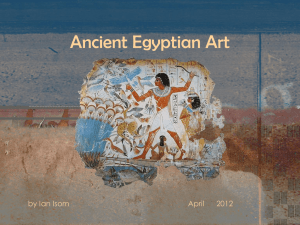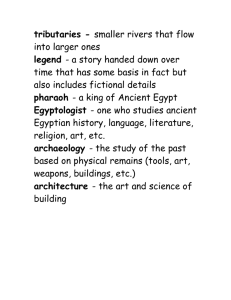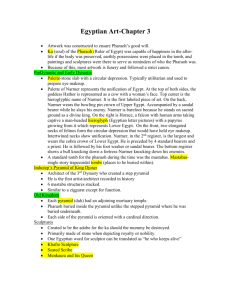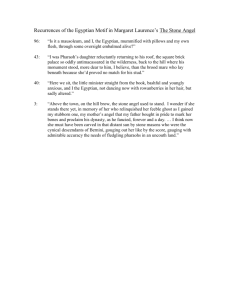Egyptian Art PowerPoint
advertisement
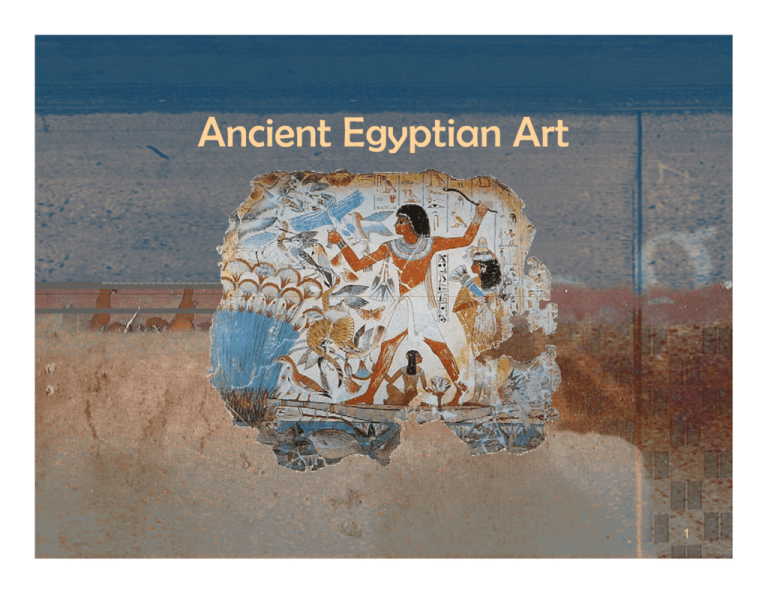
Ancient Egyptian Art 1 What can you tell me about this Mask? 2 Egyptian Cobra (Wadjet) Egyptian Vulture (Nekhbet) – Tool using bird Gold Lapis Lazuli Quartz Colored Glass Obsidian 3 Objectives • Identify the three major periods of Egyptian history. • Analyze the role that religion played in the development of art and architecture. • Describe the strict set of rules imposed on Egyptian artists. 4 3 Major Periods of Egyptian History •OLD KINGDOM (c. 2649-2150 B.C.E.) •MIDDLE KINGDOM (c. 2040-1640 B.C.E.) •NEW KINGDOM (c. 1550-1070 B.C.E.) Egypt is Located in Northern Africa 5 Old Kingdom (c. 2649-2150 B.C.E.) • In the seated portrait of Khafre, the figure has the solid, block like form of the hard diorite stone from which it was carved. •The Pharaoh is shown as sitting upright and attentive, but the head has a lifelike appearance. •The Pharaoh was considered both God and King of Egypt. • Khafre was considered to be a descendent of the Ra, the sun god. Pharaoh Khafre, c. 2600 B.C.E. Diorite. 66 inches tall. 6 Middle Kingdom (c. 2040-1640 B.C.E.) • Much of the sculpture was destroyed in this period by invaders and by the New Kingdom rulers who followed. •A fragment of King Sesotris III is an example of the skill and sensitivity demonstrated by the carvers of this period. • Depicted with a sense of Realism. • His expression conveys a look that is troubled and weary. Fragment of Head of King Sesostris III. Red Quartzite stone. 6.5” tall. 7 New Kingdom (c. 1550-1070 B.C.E.) • Nefertiti translates to “the beautiful one has come.” • Carved from limestone, coated with plaster, and then richly painted. • Depicted with more realism than the earlier periods before. • Continued tradition of figure depiction in Egyptian art. Most portraits are frontal and depict serious facial expressions. • Mother-in-law of King Tutankhamen and was Queen of Egypt for a short period before the rise of King Tut. Queen Nefertiti. c. 1360 B.C.E. Limestone. 20” inches high. 8 Religion and the Pyramids •The pyramid shape developed gradually over time. •Originally, the Egyptians buried their dead in hidden pits, but this practice changed. •Egyptians began to use sundried bricks to build mastabas. • A mastaba is a low, flat tomb. •These rectangular tombs had sloping sides and contained a chapel and a false burial chamber in addition to the true one hidden deep inside. •Eventually, mastabas were built without steps, and a point was added on the top, thus creating the true pyramid form. Step Pyramid of King Zoser, Saqqara, Egypt. c. 2681-2662 B.C.E. OLD KINGDOM 9 Religion and the Pyramids • Egyptian religion placed great importance on the resurrection of the soul, or ka, and eternal life in the spirit world after death. • The body was preserved and protected in a stone coffin, or sarcophagus, inside the pyramid for the eventual return of the ka. • The eventual return of the ka guaranteed the body immortality in the next world. • Such a tomb served as an elaborate kind of insurance against final death. The Pyramids of Giza. 10 Inside of the Tomb Trinity of King Menkaure (Mycerinus) with (left) Goddess Hathor, and (right) goddess of the nome of Diospolis Parva, green slate, h: 37.25", Bas Relief: Sculpture in which the image is raised or projects off the surface Ka statues from Tomb of Prince Rahotep and wife Nofret, Medum, Egypt, painted limestone, h: 47.5” 11 Inside of the Tomb 12 Egyptian Architecture •The Sphinx with it’s massive size and the head of Pharaoh Khafre on the body of a lion was intended to demonstrate the power of the pharaoh. •Carved from stone at the site and stands at 65 feet tall. The Great Sphinx of Giza, with the Pyramid of Khafre in the background. 13 Rules of Egyptian Art • Every part of the body must be shown from the most familiar point of view. • The head, arms, legs, and feet were always shown in profile, whereas the eyes and shoulders were presented as seen from the front. • Following these rules paintings and relief sculptures were distorted and unnatural. •Every wall in the tomb was decorated. Horror Vacui – Fear of empty spaces. Fowling Scene from Nebamun’s Tomb. 1400 B.C.E. 14 What can you tell me about this Stone? 15 Hieroglyphics • Hieroglyphics were an early form of picture writing. • These symbols, some of which represented objects, communicated information and were included in wall paintings and other art forms to help tell the story. •The signs were generally spaced to form attractive patterns frequently clusters of squares or rectangles called a cartouche Rosetta Stone: (Tri - Lingual) Hieroglyphics , Demotic, and Acient Greek 16 17 Slide Review Fragment of Head of King Sesostris III. Red Quartzite stone. 6.5” tall. Queen Nefertiti. c. 1360 B.C. Limestone. 20” inches high. 18 Slide Review The Great Sphinx of Giza, with the Pyramid of Khafre in the background. 19 Slide Review Step Pyramid of King Zoser, Saqqara, Egypt. c. 2681-2662 B.C. Pharaoh Khafre, c. 2600 B.C. Diorite. 66 inches tall. 20 Review • What are the major periods of Egyptian art? • How are the pyramids used? • What rules did Egyptian painters and sculptors have to use in art creation? 21
